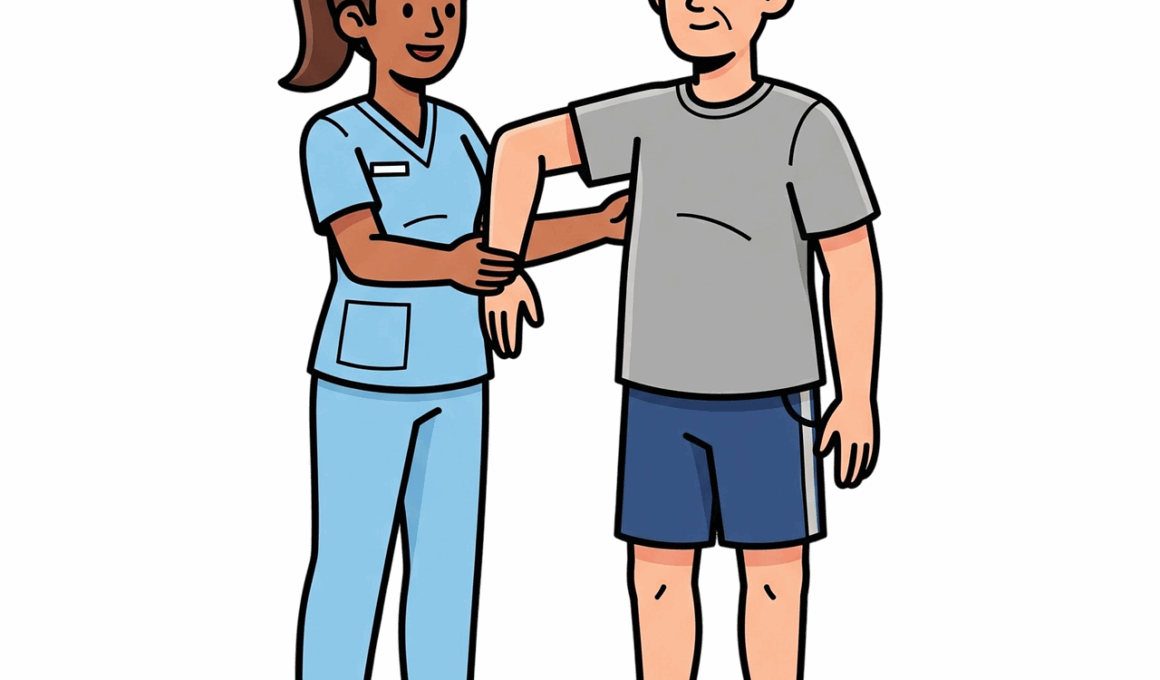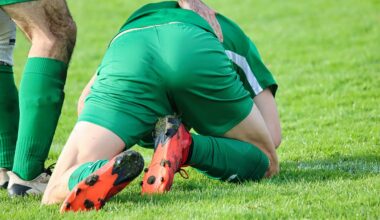How Bodyweight Training Supports Neurological Rehabilitation
Bodyweight training is increasingly recognized for its effectiveness in neurological rehabilitation. This type of exercise offers numerous advantages for individuals recovering from neurological impairments, including stroke or traumatic brain injury. The core principle of bodyweight training is that it allows patients to use their own body weight as resistance, making it highly accessible and adaptable. Neurological rehabilitation often requires specialized exercises designed to improve balance, coordination, strength, and motor control. Therefore, bodyweight training serves as an excellent foundation for these areas of focus. By harnessing the body’s natural weight, it encourages patients to engage in functional movements. These movements mimic daily activities, helping patients bridge the gap between therapy and real-life applications. Research shows that bodyweight exercises enhance neuroplasticity, promoting brain recovery and functionality. Patients become more resilient and confident as they improve. Additionally, bodyweight training is suitable for various fitness levels, allowing therapists to customize programs based on individual needs. This versatility makes it possible to integrate into rehabilitation settings seamlessly and effectively, encouraging patient compliance and positive outcomes in their recovery journey.
As patients embark on their recovery, the early stages often focus on regaining basic motor functions. Bodyweight exercises provide a controlled environment for patients to relearn essential movements safely. A structured bodyweight program can include various exercises such as squats, lunges, push-ups, and modified planks. Gradual modifications help address specific weaknesses while prioritizing safety. Moreover, bodyweight exercises help foster stability and strength in the core, which plays an integral role in overall mobility. For instance, strengthening abdominal and back muscles is crucial in regaining balance and control during movement. This becomes particularly vital for individuals who have experienced a loss of coordination. By engaging multiple muscle groups simultaneously, bodyweight exercises can effectively stimulate neurological pathways being retrained. The incorporation of bodyweight exercises very effectively reduces the risk of compensatory movements that may lead to further injuries. Hence, therapists often emphasize these exercises for patients in rehabilitation settings. Observing patients’ progression through bodyweight training develops their self-efficacy and motivation, which are essential components in full recovery. Maintaining a positive outlook empowers patients as they witness gradual improvements in strength and coordination over time.
A significant challenge in neurological rehabilitation is maintaining patient motivation and engagement. Bodyweight training advantages, including minimal equipment requirements and adaptability, can enhance enjoyment and commitment to the rehabilitation process. Patients may find traditional gym exercises intimidating or uncomfortable; however, bodyweight movements allow for training flexibility. Whether performed at home or within the clinic environment, these exercises encourage frequent practice. During the rehabilitation journey, seamless integration into daily routines is crucial. Therefore, patients can perform exercises during breaks or leisure time, promoting consistency and routine. Engaging in exercises enjoyable can lead to improved outcomes, as humorous sessions can also inhibit feelings of frustration. As patients progress, therapists can continue to challenge them and mix workouts with progressive variations. This ensures an ongoing shift in difficulty, which helps sustain interest and a desire to reach new goals. Varied patterns of exercises, such as introducing dynamic movements, allow patients to explore new limits and capabilities, all while working on crucial rehabilitation aspects. Recognizing individual improvements fosters empowerment, encouraging patients to stick with the regimen, as an airway to improve overall progress and function.
Functional Movements for Daily Living
One of the unique advantages of bodyweight training within neurological rehabilitation is its focus on functional movements aimed at improving daily living activities. When one considers what aspects of life need to be regained post-recovery, they often refer to functional capabilities such as sitting, standing, and walking. Bodyweight exercises concentrate on mastering these essential movements, ensuring patients succeed in real-world settings. Each workout session aims to mimic day-to-day tasks, making progress easier to translate into everyday situations. For instance, exercises that simulate reaching can help rebuild cognitive and motor capabilities necessary for tasks like picking up items or dressing. Therapists often emphasize restoring independence since autonomy plays a significant role in mental well-being during rehabilitation. The integration of bodyweight training into rehabilitation serves to reinforce functional skills while enhancing all-around muscle activation. Each time a patient practices these fundamental movements, reinforcement occurs through neural pathways. As a result, patients can typically perform activities with increasing ease and confidence, leading to better quality of life. Achieving functional goals promotes a sense of achievement, which is vital for mental health and motivation.
In addition to physical benefits, bodyweight training offers positive psychological outcomes for patients undergoing neurological rehabilitation. Engaging in exercise generally contributes increased feelings of competence and well-being. The ability to perform exercises independently fosters a sense of achievement. It reassures individuals about their progress and capabilities post-therapy. Bodyweight exercises often help create a routine that can be integral to combating feelings of anxiety that arise during recovery. Additionally, the social aspect of group classes and the shared experience fosters a sense of community. Patients recover more effectively when working alongside others facing similar challenges. This supportive atmosphere can lead to increased motivation, as individuals cheer each other on and celebrate progress. Therapists trained in bodyweight techniques can leverage these exercises to establish a motivating and positive rehabilitation environment. As patients engage and connect with support systems, their psychological resilience strengthens alongside their physical improvement. This holistic approach encourages dedication and diligence throughout the recovery process. Ultimately, combining physical activity with mental fortitude paves the way for successful rehabilitation and encourages long-term adherence to healthier lifestyles.
The Role of Progression and Variation
Progression and variation are critical components of any effective rehabilitation program. Bodyweight training excels in this regard, offering numerous ways to adapt exercises while ensuring safety and efficacy. Recognizing distinct limits of function is vital for therapists. They should closely monitor patient capabilities before recommending modifications. As strength and control develop, exercises can evolve from basic movements into more functional patterns. For example, a basic squat may progress to a single-leg squat, challenging stability and coordination while increasing strength demands. Incorporating variations not only keeps training exciting but also allows ongoing assessment of the patient’s capabilities. Therapists can thus easily introduce new exercises as confidence builds. By integrating these adaptations, individuals are continually challenged, preventing stagnation in the rehabilitation journey. This structured approach is vital in fostering resilience and ensuring continuous improvements. Moreover, adaptation helps patients realize their potential and embrace change. Motivating patients to push their limits reassures them how close they are to achieving full recovery. Through carefully designed progressive bodyweight training regimens, therapists can build targeted strategies that really address the unique needs of each patient while fostering independence.
The incorporation of bodyweight training into rehabilitation programs has substantial long-term benefits. Initially, individuals may not recognize how much functional independence impacts their overall rehabilitation experience. Yet, as patients engage more with bodyweight exercises, they typically experience improved physical health markers and well-being. Research indicates that consistent movement positively affects mental wellness, improved mood, diminished fatigue, and boosted energy levels. The accessibility of bodyweight training allows patients to engage in their workouts no matter where they are. As a result, maintaining a regimen tailored specifically to each patient ensures comprehensive improvements following rehabilitation. Not only does this accessibility encourage adherence to their ongoing exercise plans, but it also empowers independence in managing personal fitness post-recovery. With long-term retention of progress is paramount in ensuring lasting functional improvements. Thus, implementing bodyweight exercises is of utmost importance before transitioning patients into ongoing wellness programs. Addressing the individual’s unique challenges and endorsing independence shapes the overall experience. Ultimately, bodyweight training facilitates recovery while also enabling individuals to live their lives to the fullest beyond rehabilitation, restoring independence. Rehabilitation programs that incorporate these principles lay a strong foundation for lifelong health, wellness, and quality of life enhancements.
In conclusion, bodyweight training plays a vital role in neurological rehabilitation, effectively bridging the gap between recovery and improving daily living activities. This approach allows flexibility, accessibility, and practical application essential for enhancing physical and emotional well-being. As patients engage with their own bodies, they often find empowerment in their journey toward recovery. Focusing on functional movements tailored to individual needs fosters independence and self-efficacy. The psychological benefits reinforced by community support further bolster motivation and resilience, establishing a holistic approach to rehabilitation. Moreover, advances through progressive variations create continual challenges that promote physical growth, maintaining engagement throughout recovery. All these components ultimately unite to ensure comprehensive rehabilitation outcomes. By embracing bodyweight training techniques, therapists can deliver effective therapies built around the unique capabilities of each patient. Furthermore, these personalized therapies can fortify long-term benefits and enhance quality of life. Combining physical activity with psychological support creates not only stronger patients but also instills confidence and readiness to tackle life post-recovery. The evidence gathered shows that bodyweight training offers invaluable resources for therapists and patients alike. As families and healthcare systems recognize its potential, it will surely expand and reshape the landscape of neurological rehabilitation.


